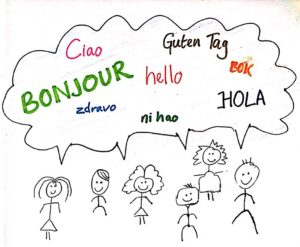Bilingualism

Definition: Bilingualism (or more generally: Multilingualism) is the phenomenon of speaking and understanding two or more languages.
Learning More Than One Language
Learning two languages depends on the amount and type of practice your child gets. The following are some basic guidelines:
- Most bilingual children speak their first words by the time they are 1 year old. By age 2, most children can use two-word phrases. Phrases like “my ball” or “more juice” can be in one or both languages.
- From time to time, children may mix grammar rules. They might use words from both languages in the same sentence. This is a normal part of becoming bilingual.
- Some children may not talk much when they start using a second language. This “silent period” can last for several months. Again, this is normal and will go away.
Myths Debunked
1. Learning two languages in childhood does not cause confusion or language delay
Children are able to learn two languages at the same pace as other children who are learning only one language.
2. Not using two languages can potentially result in language delays.
Parents who try not to use their native language may make it harder for a child to learn any language well, since it may limit the quality and quantity of language exposure that the child is receiving at home. Multilingual families should speak to their child in the language in which they feel the most comfortable.
3. Mixing two languages is not bad.
Using two languages in the same sentence is a natural form of communication used by many, but not all, bilingual speakers. If a parent switches between languages, the child will likely do so as well.
Tips For Using More Than One Language With Your Child
TIP 1: Talk to your child in the language you are most comfortable with more often (or all the time if you desire).
TIP 2: Give your child many opportunities to speak and hear both languages in different situations and with different people. Everyday routines such as mealtimes, bath time, getting dressed, and playtime are all great opportunities for talking, teaching, and learning vocabulary in either language.
TIP 3: Help your child tell the difference between the languages by having clear boundaries (e.g. using home language with family and French at the shops).
TIP 4: Read your child’s favourite books and/or tell them stories in both languages. Listening to stories many times helps language development.
TIP 5: Music-singing is a great way to introduce a second language to your child. And, it can be a lot of fun!
TIP 6: TV and videos- children’s programs are available in many languages. These programs teach children about numbers, letters, colors, and simple words.
TIP 7: Language programs-children can learn other languages at camps or in bilingual school programs. These give children the chance to use two languages with other children.
TIP 8: When a child uses grunts or gestures instead of words, or uses an incorrect word or grammar, simply model the correct word or sentence instead of correcting them. Avoid demanding that the child say something – instead, show them what to say through modeling.
TIP 9: Build on their language- repeat what the child says and add an extra word to the sentence to help them learn what they can say the next time. For example, if the child says “more” to ask for more juice, the parent can respond, “more juice!” Then repeat the phrase several times.
(ASHA, 2020; SPA, 2020)
What To Do
If your child continues to have difficulty learning more language, schedule a speech and language evaluation with a bilingual speech therapist
